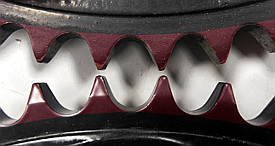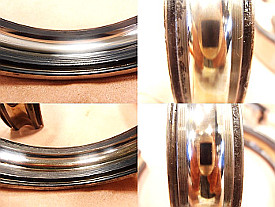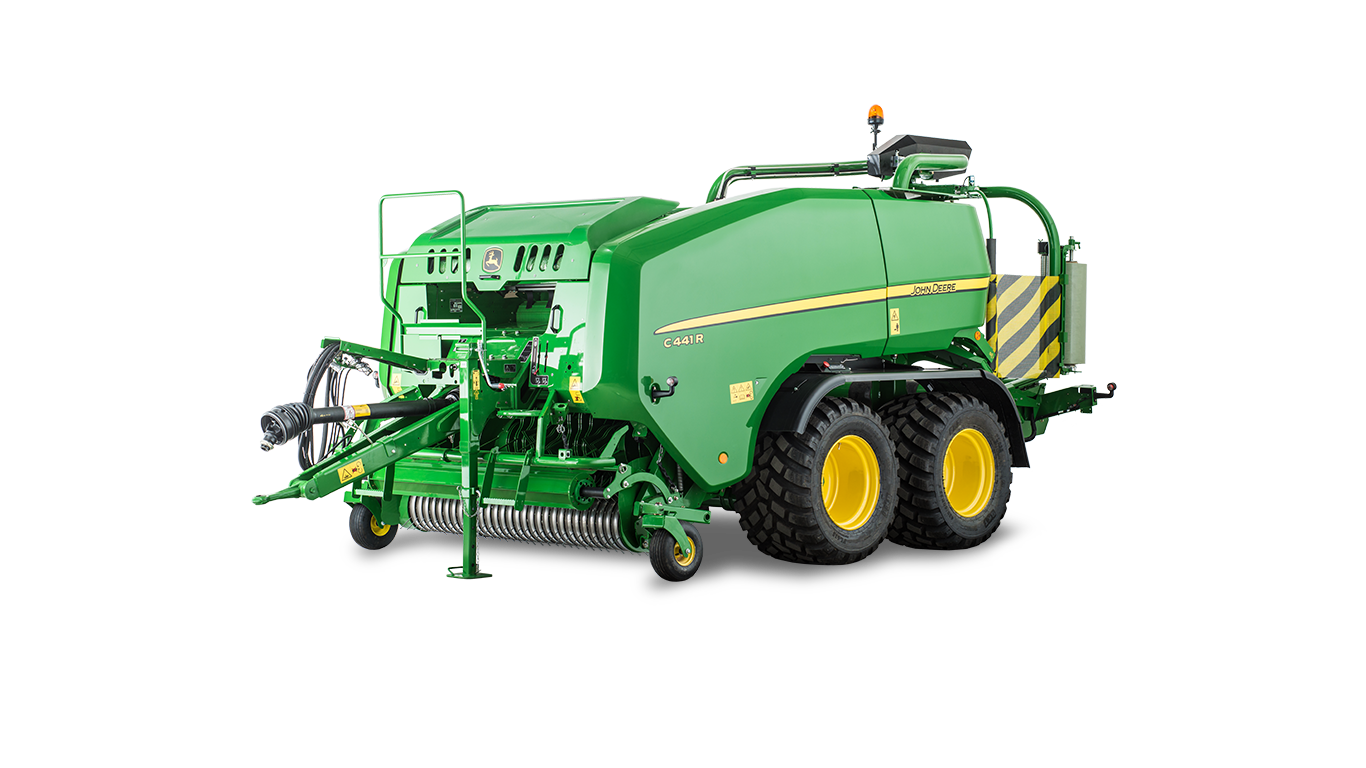
C441R
Wrapping Chamber Baler
- Tandem or single axle
- Premium specification
- Excellent in all kinds of crops
- Produces around 80 perfect bales an hour
Features
High-capacity feeding system boosts productivity
Pickup design improves capacity and durability
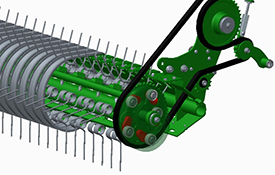 Large-diameter stripper and five teeth bars provide high picking capacity
Large-diameter stripper and five teeth bars provide high picking capacity
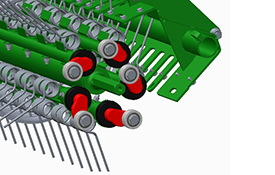 Forged cam-track links improve reliability
Forged cam-track links improve reliability
The C441R Baler uses the Premium pickup that is also equipped on the high-spec V4X1R Variable Chamber Balers. To fit all conditions, the baler is available with a 2.0-m (6.56-ft) or 2.20-m (7.22-ft) width.
The pickup, driven by 19.05-mm (0.75-in.) heavy-duty chains, features five tine bars with a low rotating speed. The large-diameter strippers allow five tine bars in the pickup. With tubular tine bars and bearings added to the cam track, all of these features provide a smooth and quiet ride with extended uptime.
In addition to the high-spec features, the C441R benefits from stainless-steel strippers, a market exclusive. Stainless steel provides the following advantages:
- No rust
- Constant gliding capacity
- High resistance to aggressive additives such as propionic acids
The C441R Balers pickup uses the cam-track design, providing a better solution to harvesting wet crops. Contrary to the cam-less design, the cam track pickup:
- Features a short space between the tines and rotor, limiting dead zone.
- Avoids pinching area, so no crops are plugged into the pickup drums.
Proven pickup lifespan
Some John Deere competitors promote cam less pickup technology, arguing low wear is inherently linked with it. Several years after a new generation pickup was introduced, John Deere analysed feedback of some of the largest bale makers in Europe.
In early 2019, John Deere identified Ernie Farren, a farmer and contractor located in Lincolnshire, United Kingdom, who makes about 5000 silage bales and 8000 straw bales per year. Ernie logged more than 67,000 bales on his first 990 Round Baler bought in 2012.
On top of contractor feedback mentioning that the “feeding system copes very well in all conditions from big first cut silage to the biggest of straw swaths... haven’t had any functional issues with the pickup on the 900’s” and “on the pickup, after 67 000 bales, I changed the driving chain and replaced a handful of tines and that’s it”, John Deere performed a complete components tear down. Below is a summary of laboratory wear investigation:
| Component | Measured wear versus new part | Comments |
| Cam roller | 0.29 to 0.34 mm (0.01 to 0.013 in.) | No significant wear |
| Cam track |
Internal track:
External track: |
No significant wear on inner track with
|
| Chain sprocket |
Tooth wear = 1.3 mm (0.05 in.) (on average) |
Wear still in working condition. Part was in very good working condition. |
| Tine bar bearings |
No major wear on bearings inner/outer tracks |
Six bearings need to be replaced. |
After full pickup component disassembly and checking, the factory found that among all pickup components, only six tine bar bearings would need to be replaced.
As most pickup components are similar between round baler models (except for the F4X0E), conclusions are valid for both standard and Premium pickups.
With these findings, John Deere proves that the versatility of cam track technology can also cope with long durability and low cost of maintenance.
Roller baffle optimizes crop flow
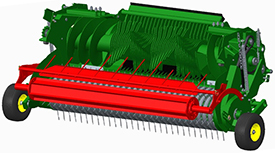 Adjustable roller baffle
Adjustable roller baffle
As standard equipment, a roller baffle allows optimization of crop flow.
The roller baffle can:
- Gives a spring effect to the crops, even the shortest and facilitates crop picking
- Pull the crops thanks to the high steel roller inertia
- Provides uniform windrows, allowing a faster and constant working speed
- Minimize crop loss
Thanks to two chains that are easily locked, the roller baffle can be adjusted to the windrow size in a second. The exclusive kinematic and compressing rods give a free motion and avoid narrowing, no matter the roller height. The large, 225-mm (8.9-in.) diameter of the system gives an easy rotation and avoids dozer effect.
High-capacity (HC) rotor for higher productivity and durability
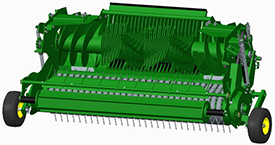 MaxiCut™ HC 25 Premium has a single axis for rotor and converging augers
MaxiCut™ HC 25 Premium has a single axis for rotor and converging augers
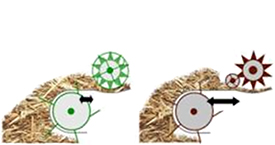 HC rotor limits plugs
HC rotor limits plugs
To maximize productivity in the toughest swaths, the C441R Baler features an HC Premium rotor design. Converging augers are aligned with the rotor, limiting the free space between pickup teeth and rotor. Plugging risk is also decreased and crop transfer is highly improved. The simple HC Premium rotor design also reduces the number of moving parts and provides reliability. For example, stress on the rotor is distributed along the entire rotor to avoid overhang load on the bearings. Additionally, all rotors feature tines that are made of Hardox® wear plate which drastically improves wear resistance, especially in rocky fields.
The C441R is only available with a precutter, offering space between knives as short as 40 mm (1.57 in.) or 80 mm (3.15 in.).
|
MaxiCut HC 13 Premium | MaxiCut HC 25 Premium |
Number of knives |
0, 13 |
0, 12, 13, 25 |
Space between knives |
80 mm (3.15 in.) |
40 mm (1.57 in.) or |
Best use (crop type) |
Silage, hay, and straw |
Silage, hay, and straw |
High cutting quality provides better forage
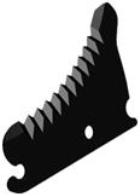 Double-heat treatment for concise cut and long life
Double-heat treatment for concise cut and long life
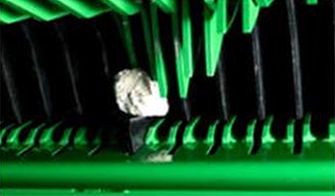 Individual knife security for quality forage
Individual knife security for quality forage
The C441R Balers are efficient in baling a high amount of cut silage. The MaxiCut HC 13 Premium and MaxiCut HC 25 Premium feature exclusive high- quality knives, providing several advantages:
- Bulk heat treatment to reduce risk of knife breakage.
- Surface heat treatment of the cutting area to provide better cutting quality and knife durability.
Select number of knives from the cab to increase uptime
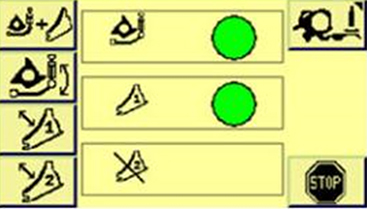 Knife sets from the cab with MaxiCut HC 25 Premium
Knife sets from the cab with MaxiCut HC 25 Premium
The C441R can be used on several kinds of crops, in which knives can be engaged or removed. No matter the rotor type or monitor, this operation is easily managed from the cab.
When using the MaxiCut HC 25 Premium precutter, crops can be cut as short as 40 mm (1.57 in.), but only half of the knives can be engaged. This system proposes to use two different sets of knives for the same cutting width, to allow the use of sharp knives longer. By using sharpened knives versus blunt, fuel consumption can be decreased by up to 10 percent.
Drop floor can remove the worst plugs
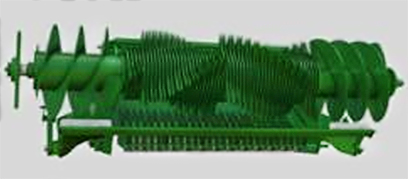 Drop floor covers rotor full width
Drop floor covers rotor full width
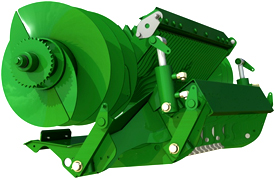 Parallel kinematics avoids narrowing
Parallel kinematics avoids narrowing
No matter the operator experience, plugs can still occur, especially with large silage swaths. The C441R is equipped as a base with a drop floor unplugging system. The C441R drop floor features exclusive advantages, such as:
- Full-width design - by covering the full pickup width, the device can remove plugs, even located under converging augers.
- Parallel kinematic - no rear or front hinge means no narrowing. The C441R drop floor offers a constant 40-mm (1.6-in.) free space through the feeding channel when activated. This is enough to decompress the crops and avoid crop loss.
No matter the precutter or monitor type, the drop floor unplugging system can be easily managed from the cab.
Heavy-duty bale chamber provides density, durability, and multi-crop capability
Rolls manufacturing provides long lifespan
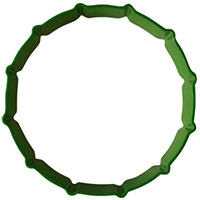 12 ribs roll
12 ribs roll
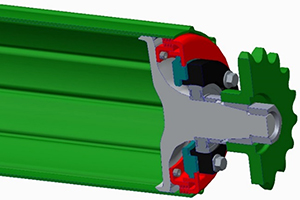 Bearings protection feature chicane and lips plastic seal
Bearings protection feature chicane and lips plastic seal
In order to provide high-quality rolls, the C441R rolls are not two half shelves welded together. John Deere only uses tubes that feature 12 ribs to better grip the crops, even in very dry conditions. Compared to the 10-rib rolls, the 12-rib solution offers up to 20 percent more contact points with the bale for an enhanced bale rotation. The dedicated manufacturing process produces an accurate cylindrical shape, avoiding vibration.
 Fully greaseable bearings can be replaced easily
Fully greaseable bearings can be replaced easily
All rolls are assembled on larger bearings that are 50 mm (1.97 in.) in diameter with a 90-mm (3.54-in.) width or 55 mm (2.17 in.) in diameter with a 100-mm (3.94-in.) width. On the left side of the machine the bearing load capacity has been increased by 20 percent and on the right side by 35 percent. All bearings are greaseable. Additionally, a lips plastic seal integrated in chicane locks off debris, silage juice, and moisture from bearings.
In order to improve the machine's durability, roll bearings feature 20 percent more load capacity on the left side of the machine and 35 percent more on the right side than on the previous series.
Specific rolls handle the stress
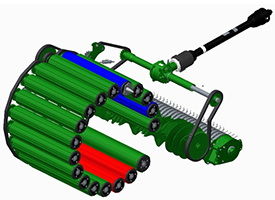 Blue and red rolls are heavy duty
Blue and red rolls are heavy duty
All rolls feature upgraded quality steel, providing 20 percent higher yield strength. Depending on their positions, the rolls do not all carry the same load and stress, specifically:
- Rolls numbered 14 and 17 (blue) transmit the load of the main drive to the secondary chains (front bale chamber part and tailgate) and the pair of bottom roll numbered 10 and 11 (red) carry most of the bale weight. Due to this specific stress, these rolls feature a higher thickness of 4 mm (0.16 in.) instead of 3.2 mm (0.13 in.) and specific shafts in order to achieve requested durability.
18th roll
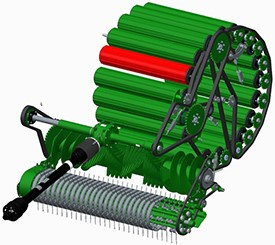 18th roll
18th roll
In order to enhance multi-crop capacity in very dry crops, the baler is equipped with an 18th roll that pushes the bale formation capacity further inside the chamber. The improved power transmission between the chamber and the bale also increases the total machine efficiency and reduces fuel consumption by about 7 percent.
For existing C441R Balers sold with only 17 rolls, a retrofit kit including the 18th roll is available as an attachment.
Adjust bale size and density independently and maximize bale weight
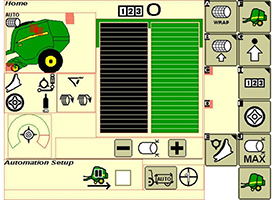 Green column indicates bale diameter target – black column indicates bale diameter status
Green column indicates bale diameter target – black column indicates bale diameter status
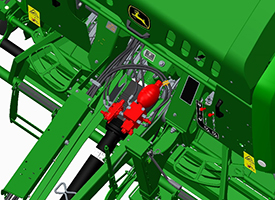 Bales density can be adjusted from ISOBUS monitors through proportional density valve
Bales density can be adjusted from ISOBUS monitors through proportional density valve
The balers allow operators to maximize bale weight and minimize total production costs due to shipping and storage needs. The bale diameter can be easily adjusted from between 1.25 m to 1.35 m (4.10 ft to 4.43 ft) from the monitor. The settings (seven steps) allow an accurate and quick choice. The bale diameter is controlled by contactless sensors, which provide long durability and error proof monitoring.
The bale density and size are not directly linked on the C441R Balers. Depending on the crop type, operators can independently choose a small-diameter bale with the highest density, a 1.30-m (4.27-ft) bale with higher density, or large-diameter bale with low density. A pressure gauge located on the monitor screen communicates the density is linked to the density harness. The density is easily adjusted from the monitor.
The density hydraulic circuit is closed and isolated, meaning that there is no continuous oil flow requiring extra power consumption.
The density booster is installed in base on the C441R Baler. The hydraulic device maintains high-hydraulic pressure in the density bracket during the complete baling process, even when using a tractor with decreased hydraulic performance.
Through the density booster, the tailgate stays firmly closed from the start of bale formation to the end of the tying process. This increases the bale density and weight. The effect of the density booster is especially visible on small bales of 1.25 m (4.10 ft).
By limiting the trapped air, forage quality is also highly enhanced.
Damped gate
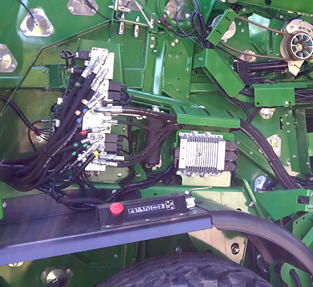 Tailgate motion is damped thanks to hydraulic valve management
Tailgate motion is damped thanks to hydraulic valve management
Thanks to advanced hydraulic components and software, the opening and closing gate motion simultaneously provides very fast cycles and minimizes chocks at the end of motion due to gate inertia. High machine productivity is achieved while machine frame stress is decreased.
40-rpm wrapping arms - bale faster than ever
Balanced cycle time between baling and bale wrapping functions is key
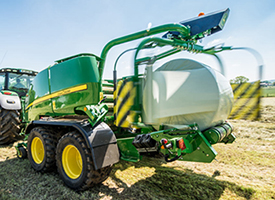 Film wrapping arm speed is 40 rpm
Film wrapping arm speed is 40 rpm
The design of a very efficient and productive baler is not sufficient if the film wrapping unit is not able to follow the same rhythm of work. John Deere engineers came up with smart solutions to eliminate bottle necks and boost total productivity.
Cycle times have been decreased and the system allows a bale wrapped with six layers of film every 39 seconds, meaning a maximum productivity of 92 bales per hour. This performance is from 7 percent to 22 percent better than others in the worldwide market.
The core trick to achieve such productivity is in an innovative and powerful hydraulic motor which can drive the film wrapping arm at a 40-rpm speed (a record on the market) and without any compromise for operator safety, as an integrated and automatic brake could stop every motion in a short time.
Changing film rolls is quick and easy
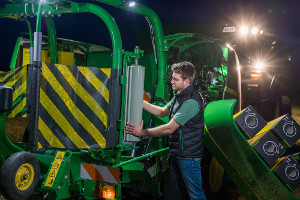 12 film rolls can be loaded on the C441R
12 film rolls can be loaded on the C441R
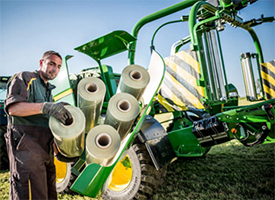 12 film rolls allow enough autonomy for a long day of work
12 film rolls allow enough autonomy for a long day of work
The C441R is equipped with a unique film roll storage device. Each film roll weighs about 20 kg (44 lb) and must be changed very often; this system has been designed to simplify loading and unloading operations.
On each side of the machine, five rolls are installed on a moving arm, hydraulically piloted. Managed by a control panel standing on both sides of the baler, the system prevents operators from running from the left side to the right side to operate storage racks, as is the case on several competitive wrapping balers. The loading/unloading position has been set up to be as close as possible to the wrapping arms at a very ergonomic height.
Details count: in the transport position, the film storage device is covered by a roof which protects film rolls from rain. This protects the film roll core, often made of cardboard, from damage.
Film binding offers complementary tying solution
Film binding available on C441R
 Film binding on the C441R
Film binding on the C441R
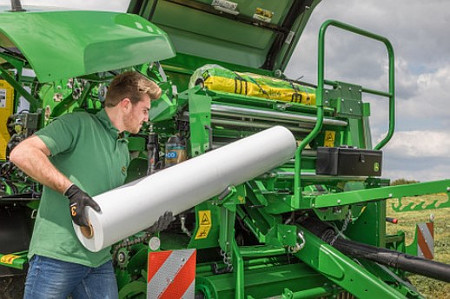 Loading gutter and tray
Loading gutter and tray
Facilitate silage bale opening, make crop packaging recycling easier and save some crops with the film binding solution.
- Switching from net to film binding is easily performed in less than 5 minutes. There is no need to remove net or film roll. It is designed for XtraCover™ film and is compatible with 1380-mm (4.5-ft) film rolls.
- Experience comfortable roll loading thanks to a low gutter and tray (1.4 m [4.6 ft]). This means low risk of film roll damages. Film binding key parameters are adjusted from the display.
- An ultrasonic sensor checks for proper film process, and an intuitive pop-up dialog box allows for re-launch in case of failure.
An optional video camera offering extra peace of mind can be added to film binding system. This camera is compatible with the 4240 Universal Display or can be plugged directly into the dedicated 17.8-cm (7-in.) TFT screen.
Film binding versus net binding - make the right choice
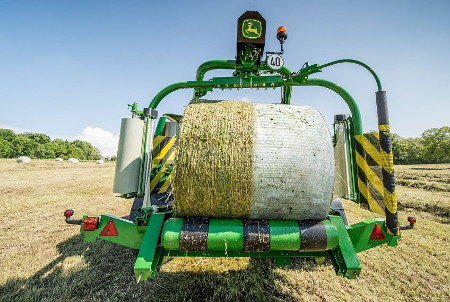 Two binding solutions for the same kind of bale
Two binding solutions for the same kind of bale
Neither film binding nor net binding are universal solutions. Choosing film instead of traditional net for a wrapped silage bale must be a deeply analyzed decision that considers both systems’ advantages.
- Film bound bales are easier to open during winter because film does not grab into frozen crop fibers.
- Because it is not required to separate binding film from wrapping film for recycling operations, film bound bales can be open at least 25 seconds faster.
- Smooth and wet silage bales (English rye grass and white clover at approximately 50 percent moisture) bound with film have lower loss due to fermentation, gas leakage, and mold. A survey conducted by independent French organization ARVALIS reveals a 2.7-kg (6-lb) lower dry matter loss when using film instead of net. This statement is not valid for other kinds of crops.
- Forage quality improvement (often linked to a lower amount of air in film bound bales) has not been demonstrated. Even if a 6 to 7 percent higher density for film bound bales has been signaled, net or film bound bales offer similar nutritional quality after 7 months of storage.
- Overall net binding costs are 0.96€ lower per bale than film binding.
- Crop packaging cost is 0.69€ lower for a bale bound with net than with film.
- Wrapping baler amortization costs per bale are 0.20€ lower for a machine equipped with a net system only.
- Because of a 5.5 second faster binding process, net binding allows you to save an additional 0.08€ per bale in gas, tractor amortization, and operator costs.
- This faster process is linked to a lower number of layers required (at least 1.3 fewer layers for net versus film) that saves 4 seconds. Downtime related to roll autonomy is also more limited with net, which requires a single stop every 450 bales while film requires four stops. This provides an extra 1.5-second advantage per bale for net versus film.
Tandem or single axle - the power of choice
Tailor the machine to producer's needs and budget
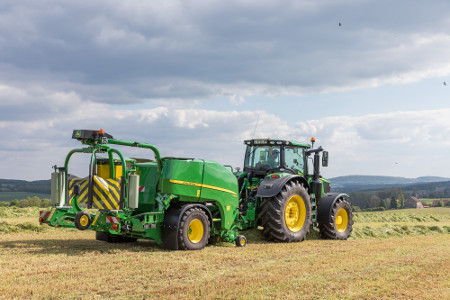 Baler on a single axle
Baler on a single axle
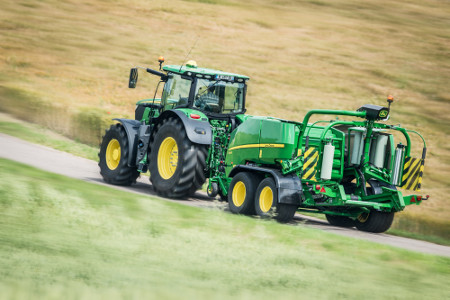 Baler on a tandem axle
Baler on a tandem axle
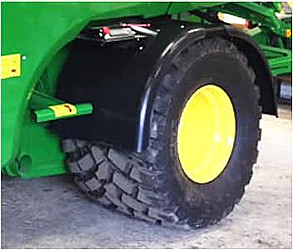 Extra-wide 750-mm (29.5-in.) single axle tires
Extra-wide 750-mm (29.5-in.) single axle tires
 Extra-wide 620-mm (24.4-in.) tandem axle tires
Extra-wide 620-mm (24.4-in.) tandem axle tires
Depending on crop type, field size, weather conditions, and road transport constraints, growers have a professional sight on what fits best their needs when it comes to an axle.
A compact machine (less than 6.8 m [22.3 ft] total length) has been designed that can be fitted with a single axle equipped with 600/55R22.5 tires and stays below 3 m (9.8 ft) width. In such configuration, total machine weight is kept below 5,9 tons. This multipurpose solution optimizes machine maneuverability, fits most field conditions, and offers lower cost of acquisition. For those who bale in more challenging field conditions, 750/45R22.5 tires are also available; in this case, compromise will be made since the machine width will reach a bit more than 3.3 m (10.8 ft).
The same unit can be mounted on a tandem axle. This is ideal for producers who are looking for very low ground pressure and/or more comfort during long transport rides. The cost will be higher, though. 500/45-22.5 large-diameter tires (around 1.05-m [3.4-ft] diameter) will keep the machine width below 3 m (9.8 ft). John Deere also offers an ultimate solution with a 620/40R22.5 tires size to make the machine able to float on the wettest field conditions.
Facilitated maintenance increases uptime
Single-piece side panels offer easy access to components
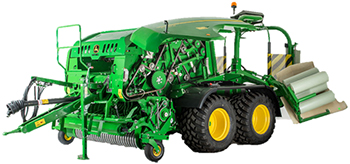 Side panels offer easy access to machine
Side panels offer easy access to machine
The C441R features a single-piece side panel with a gull wing opening to provide full access to the baler side components. No additional shielding needs to be remove to maintain the baler.
The C441R side panels are made of a single-skin plastic shield mounted on a rigid steel frame, providing rigidity and long durability. The gas cylinders facilitate panel motion and lock it in the upper position safely.
Automatic chain lubrication increases component durability
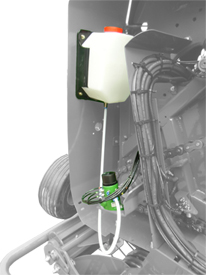 4-L (1.05-gal.) tank
4-L (1.05-gal.) tank
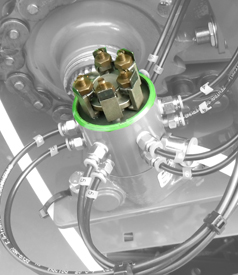 Independent settings for all chains
Independent settings for all chains
Automatic chain lubrication is offered as standard on the C441R Balers to increase the baler lifespan.
This device features a 4-L (1.05-gal.) high-capacity tank, providing autonomy. The pump delivers a continuous flow to all chains as soon as the power take-off (PTO) is engaged. Output can be individually and accurately adjusted. Volumetric pump guarantees to lubricate each chain properly, no matter if it is located a few centimeters (inches) from the pump or farther away.
This is designed to work with the John Deere bio multi-lube oil, available through the Parts channel.
Automatic greasing system with cartridge provides an affordable and comfortable solution
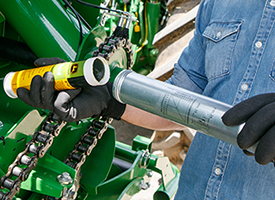 Standard grease cartridge inserted into steel tube
Standard grease cartridge inserted into steel tube
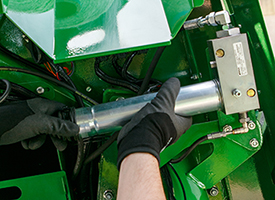 Steel tube inserted into the greasing system
Steel tube inserted into the greasing system
The C441R is delivered as standard with an automatic greasing pump using cartridge and avoiding daily maintenance. The pump is hydraulically piloted and sends an adjustable quantity of grease to intermediate banks during each opening and closing tailgate cycle.
The system is easily filled by inserting a standard grease cartridge (400 g [14.1 oz]) into the steel tube. This system allows a clean and efficient solution, offering two to seven days autonomy.
When empty, a mechanical visual indicator located on the baler front panel warns the operator to change the cartridge.
ISOBUS automatic greasing system with tank offers advanced settings and high autonomy
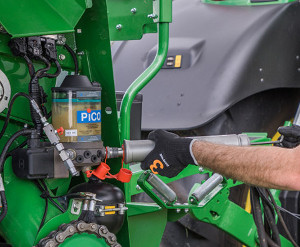 1200-g (42.3-oz) grease capacity
1200-g (42.3-oz) grease capacity
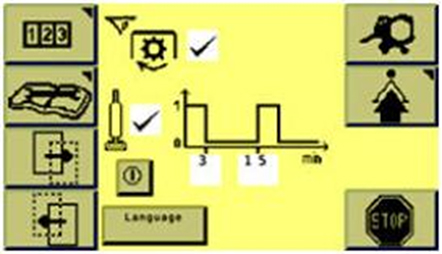 All settings from the display
All settings from the display
For the most demanding users, the C441R can be equipped with a high-spec automatic greasing system. As for the cartridge solution, this pump delivers grease to all points requiring some daily maintenance. This option offers several advantages:
- High autonomy with 1200 g (42.3 oz) of grease (three standard cartridges). Re-filling is only required once a week to once a month.
- Refilling is possible through the standard zerk.
- Refilling is possible with a dedicated high-throughput plug, minimizing downtime (fast refill pump available as attachment).
- Greasing and non-greasing time is adjustable from the monitor.
- Greasing activation can be done from the monitor.
- Greasing process status is displayed on the monitor.
Toolbox facilitates maintenance
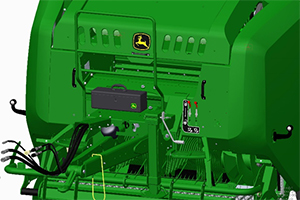 Convenient toolbox location
Convenient toolbox location
A toolbox is available as an option for C441R Balers. This device provides storage of tools often used to maintain the baler, such as a grease pump, wrenches, or screwdrivers. The toolbox is conveniently located at the front of the baler.
Side control panel allows manual operation from the ground
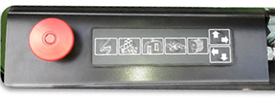 Manual control panels are available on each side of the machine
Manual control panels are available on each side of the machine
The machine offers the possibility to pilot the following functions from both sides of the machine with the touch of a finger:
- Rear gate - open and close
- Bale transport table - back and forth
- Wrapping arms
- Stretched film scissors
- Film roll storage
Vision pack enhances operator’s baling experience
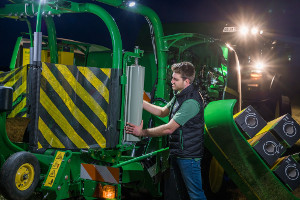 Lighted wrapping area
Lighted wrapping area
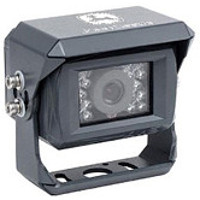 Rear camera on the baler
Rear camera on the baler
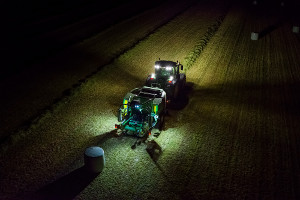 Working lights on baler facilitate night operations
Working lights on baler facilitate night operations
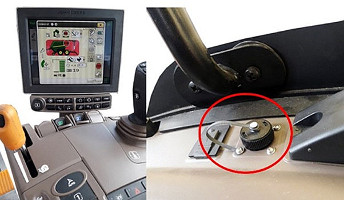 GreenStar™ 3/Gen 4 display with video preparation
GreenStar™ 3/Gen 4 display with video preparation
A pack including a rear camera, two rear working lights, a light for the dumping area, a light on the net area, one light on each side panel, and a beacon light is available as an option. This pack facilitates the operator’s working and maintenance operations, especially in dark conditions. The two side working lights facilitate changing film rolls at night.
On top of the lights, a rearview camera allows to control the bale unloading process directly from the cab.
The factory-installed camera offers:
- Higher definition with 77 percent more pixels
- Wider view of 120 degrees instead of 90 degrees
- Night vision thanks to infrared light-emitting diodes (LEDs)
- Better visibility in very bright or contrasted environments
- Integrated heating system to prevent dew from forming on the lens and obscuring the screen
- Long 10-m (32.8-ft) harness for ease of use
The camera is not delivered with a dedicated screen but is designed to be plugged into John Deere tractors that feature video preparation/capacity.
When paired with the 4240 Universal Display and plugged into a John Deere tractor cab cornerpost, a dedicated bulkhead harness is required to display images on the monitor screen.
 Dedicated screen with single camera view
Dedicated screen with single camera view
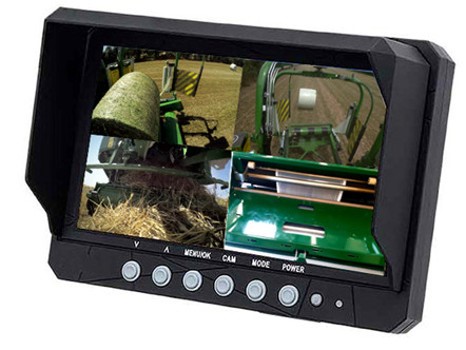 Dedicated screen with four-camera view
Dedicated screen with four-camera view
If not using a John Deere tractor with the 4240 Universal Display or GreenStar 3/Gen 4 integrated CommandCenter™ system, a dedicated screen is available.
- Clear picture with 17.8-cm (7-in.) 16/9 high-definition color screen
- Compatible with up to four cameras with split-screen or toggle-screen function
- Adjustable brightness and contrast provide optimum viewing
- Anti-reflection screen decreases glare
Fit needs with wide monitor choice
4240 Universal Display enhances operator comfort
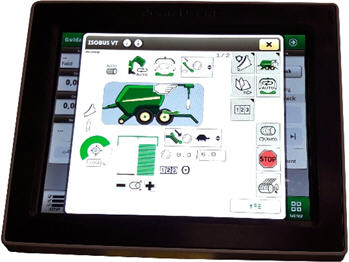 4240 Universal Display with C441R main working page
4240 Universal Display with C441R main working page
The C441R can be delivered with various monitors. At the top of the baler range, the 4240 Universal Display can be ordered. This monitor features a 21.5-cm (8.5-in.) diagonal color display. The touchscreen offers an intuitive and user-friendly interface that easily allows operators to adjust and control various settings.
The 4240 Universal Display is an ISOBUS certified display. The following settings and information are accessible from the monitor:
- Bale diameter setting and status
- Bale density setting and status
- Gate and bale position
- Twine/net settings and status
- Drop floor management and status
- Knife management and status
- Greasing parameters and status when automatic greasing option is chosen
- Bale counter (99 resettable options plus one total bale count option)
- Video (if plugged into a John Deere tractor cab cornerpost and teamed to vision pack option, PFP17673 bulkhead display harness is mandatory)
- Electrical harness and sensor status
The 4240 Universal Display offers extended capabilities for guidance, spraying management, farm management, and FarmSight™ applications.
To be used with ISOBUS or non ISOBUS tractors, the 4240 Universal Display option is delivered with the following components:
- 4240 Universal Display
- Baler to rear tractor ISOBUS plug
- Baler ISOBUS plug to display harness – plugged into to tractor battery
- Tractor cab corner to monitor harness
No monitor offers a solution for modern ISOBUS tractors
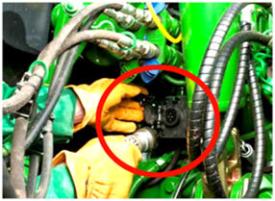 Just plug and bale
Just plug and bale
Operators with an ISOBUS display already integrated into the tractor do not need to buy an unused component. The C441R Baler can be ordered without the monitor. In this case, the baler is delivered with an ISOBUS plug that must be connected to the tractor's rear ISOBUS plug.
Monitor support for John Deere 5XXX, 6XXX, and 7XXX Tractors
Monitors, no matter the type, are not delivered with support.
A support allowing the monitor to fasten to the cab corner or side is available for the 5XXX, 6XXX, and 7XXX Series John Deere Tractors.
This monitor bracket can also be delivered as a field attachment.
Monitor support for John Deere SG2 cab and other brands
Monitors are not delivered with support.
A support allowing the monitor to fasten to the cab is available for following tractors:
- John Deere with SG2 cab (produced before 1992)
- All others brands with specific modifications
This monitor bracket can also be delivered as a field attachment.
Related Products
-
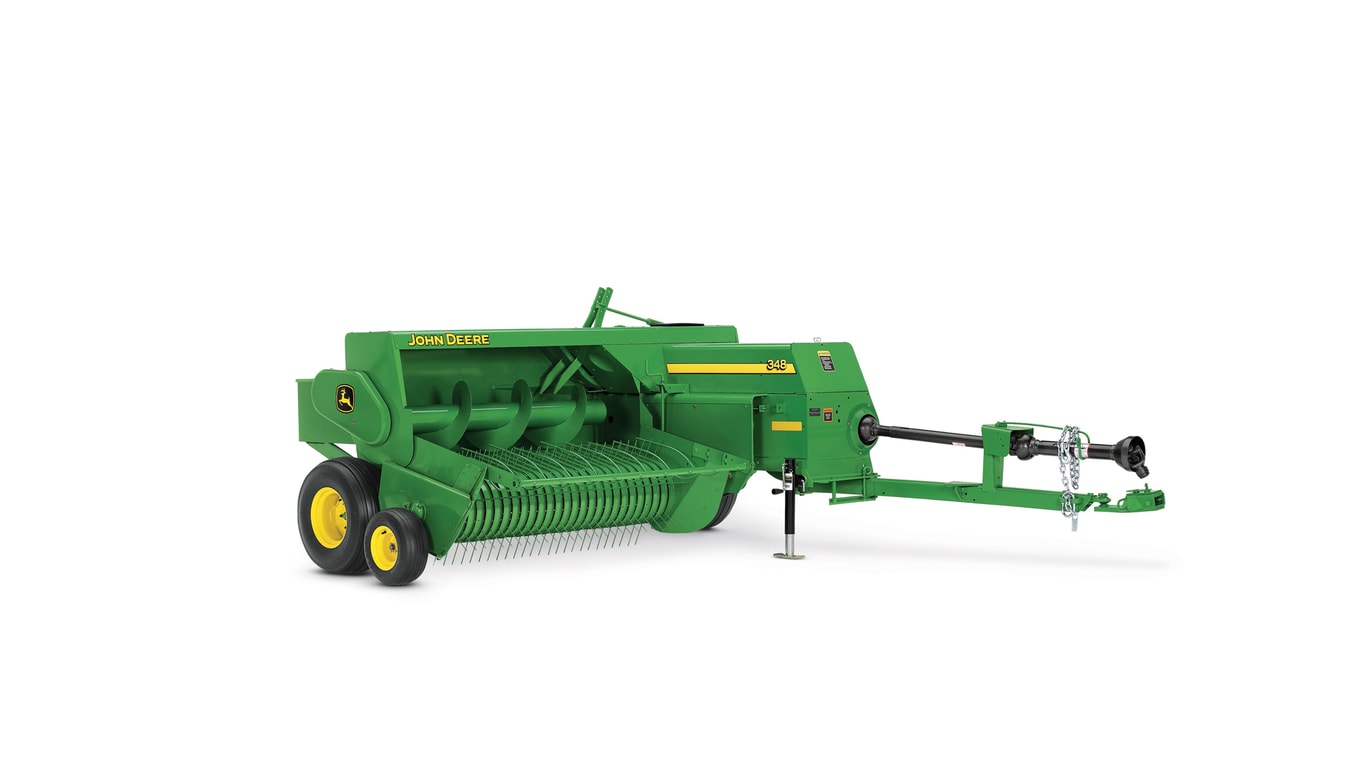 348 Small Square Baler
348 Small Square Baler -
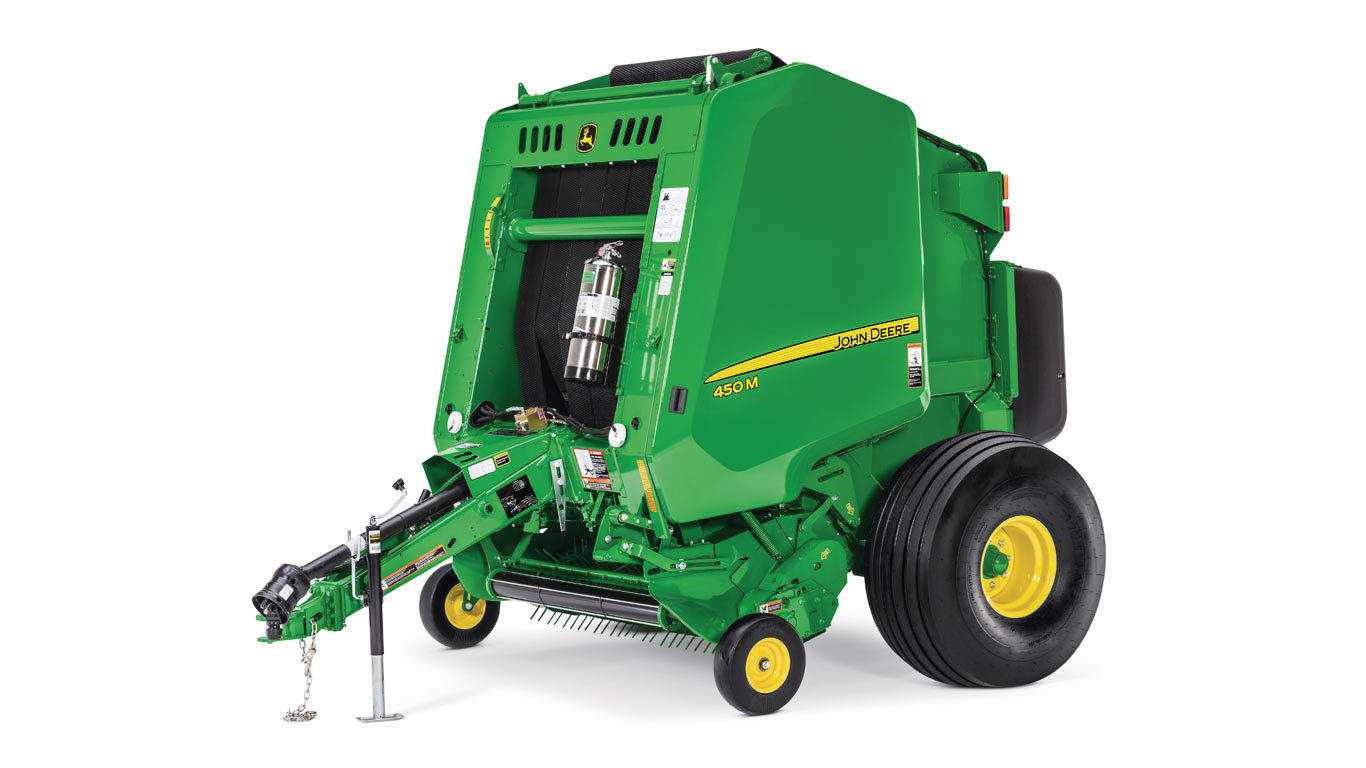 450M Round Baler
450M Round Baler -
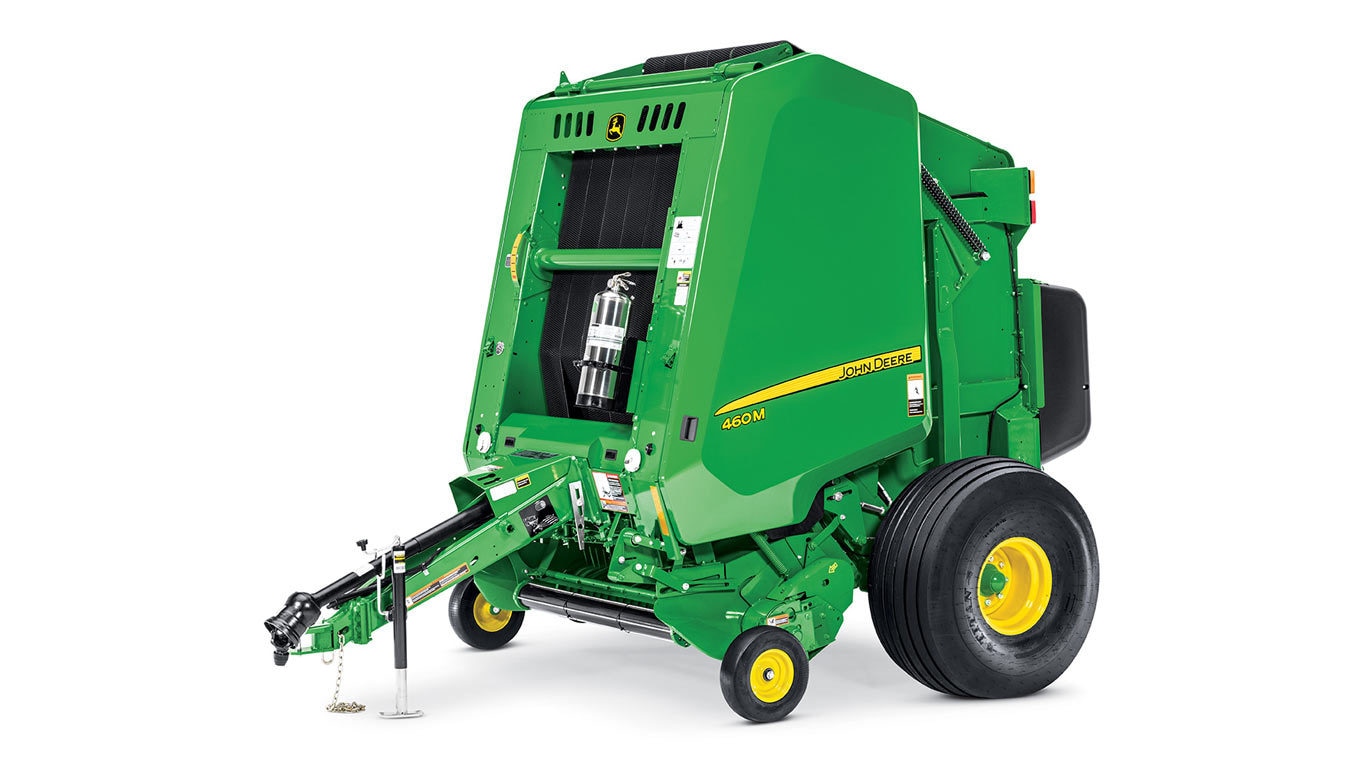 460M Round Baler
460M Round Baler -
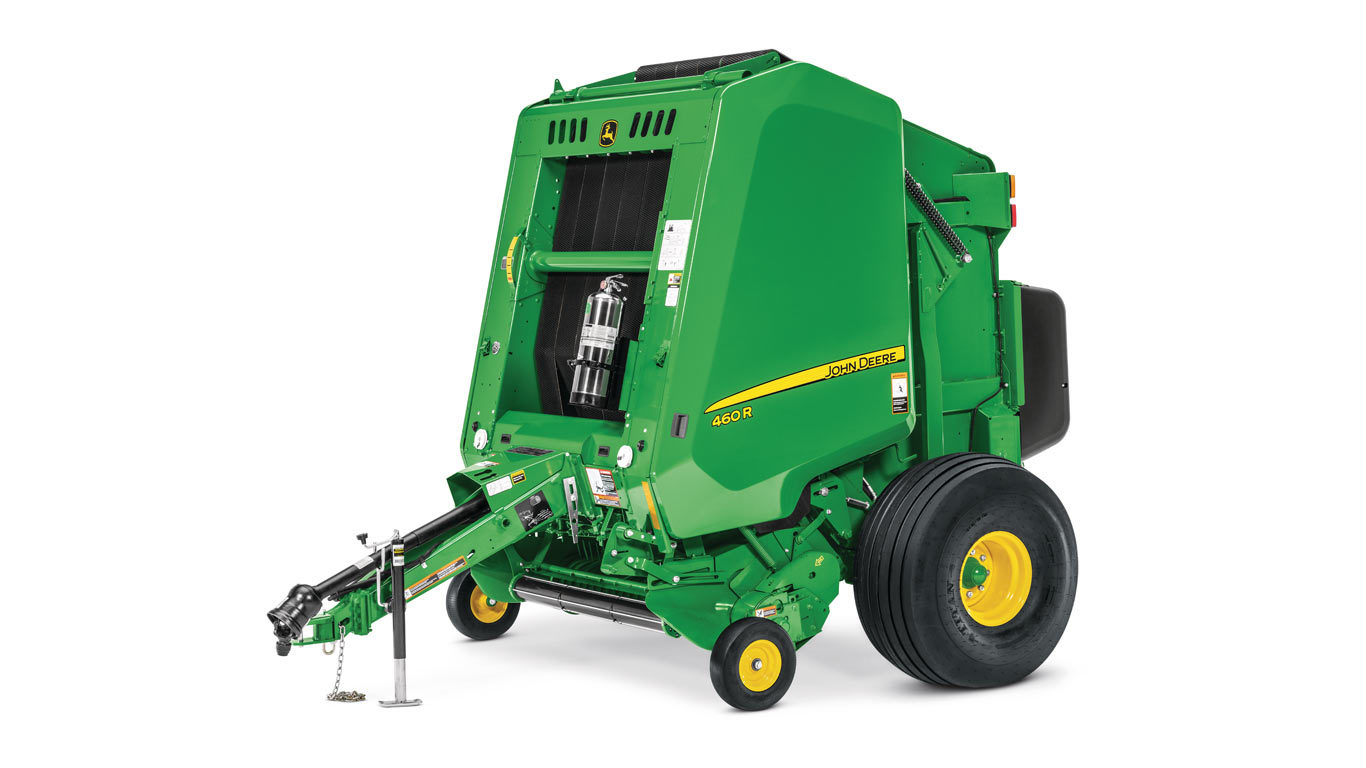 460R Premium Round Baler
460R Premium Round Baler -
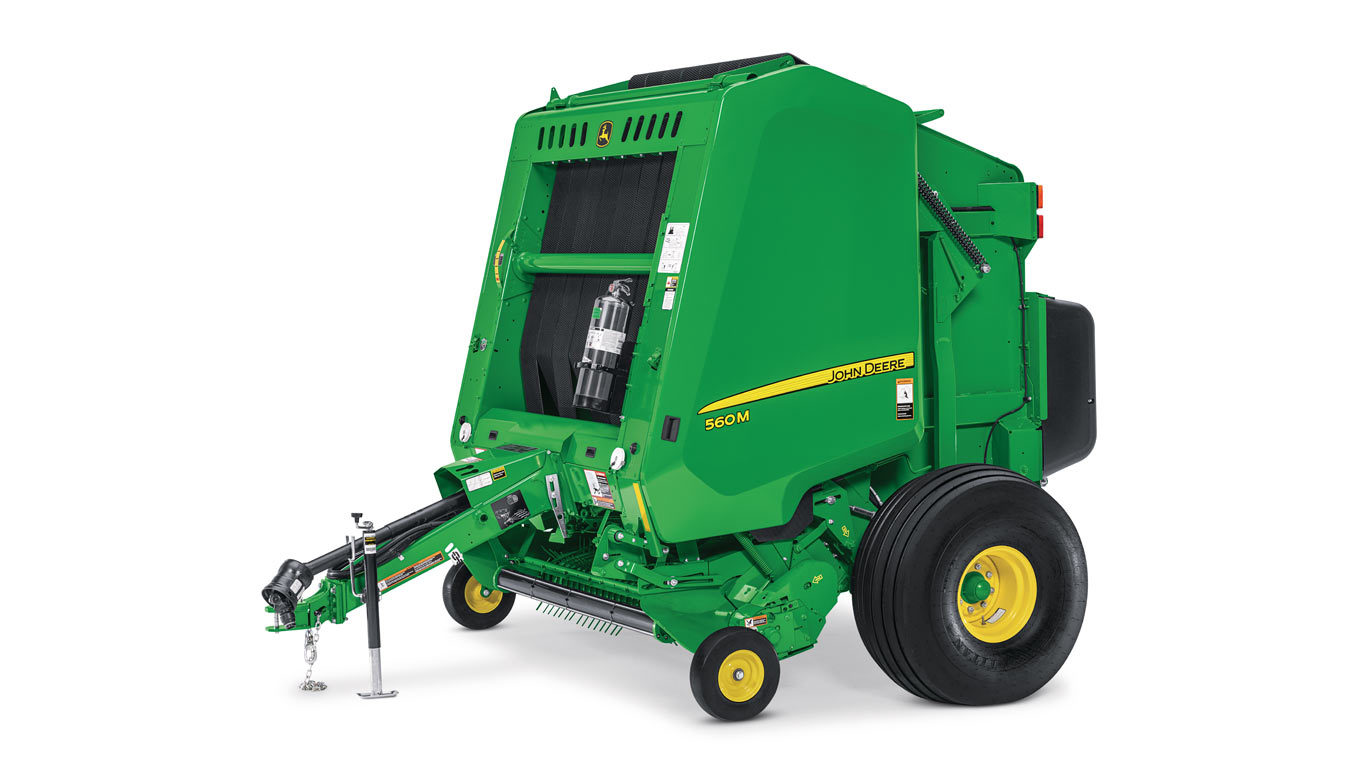 560M Round Baler
560M Round Baler -
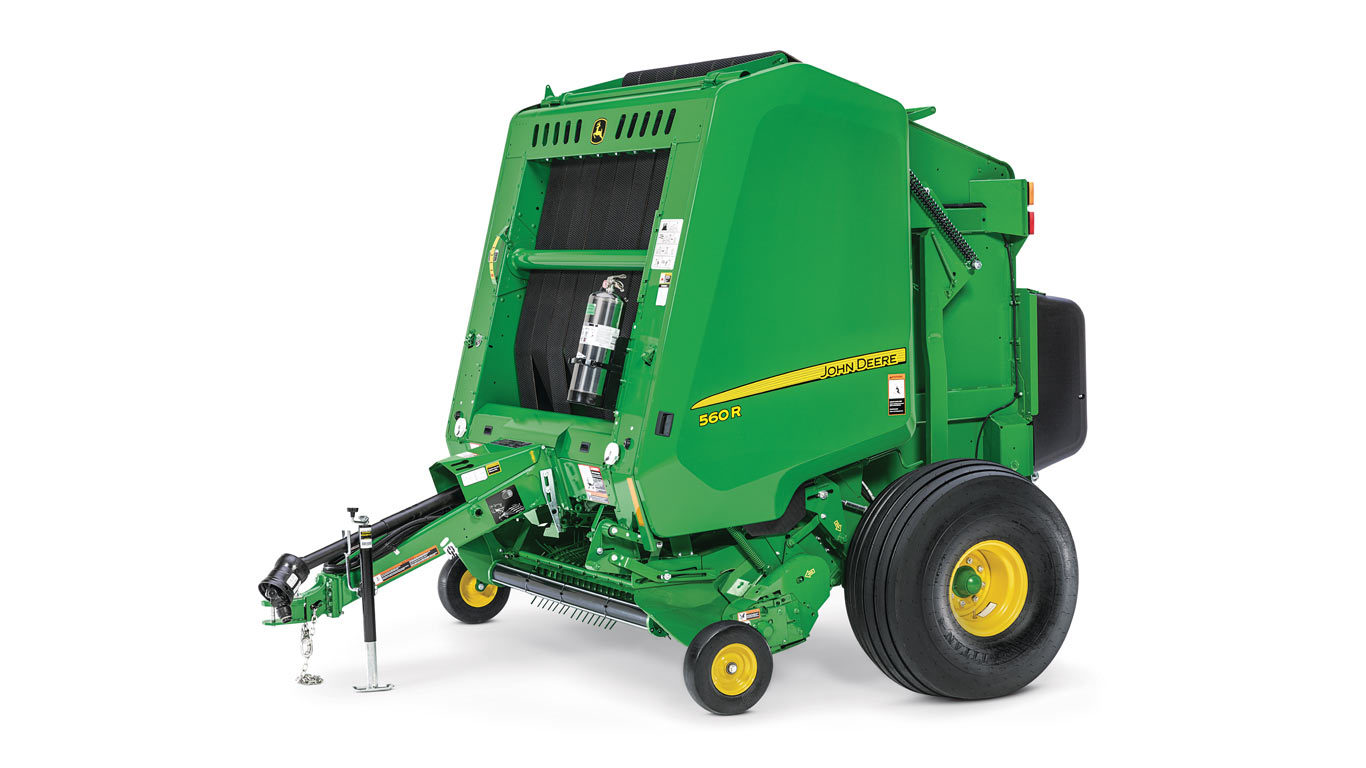 560R Premium Round Baler
560R Premium Round Baler -
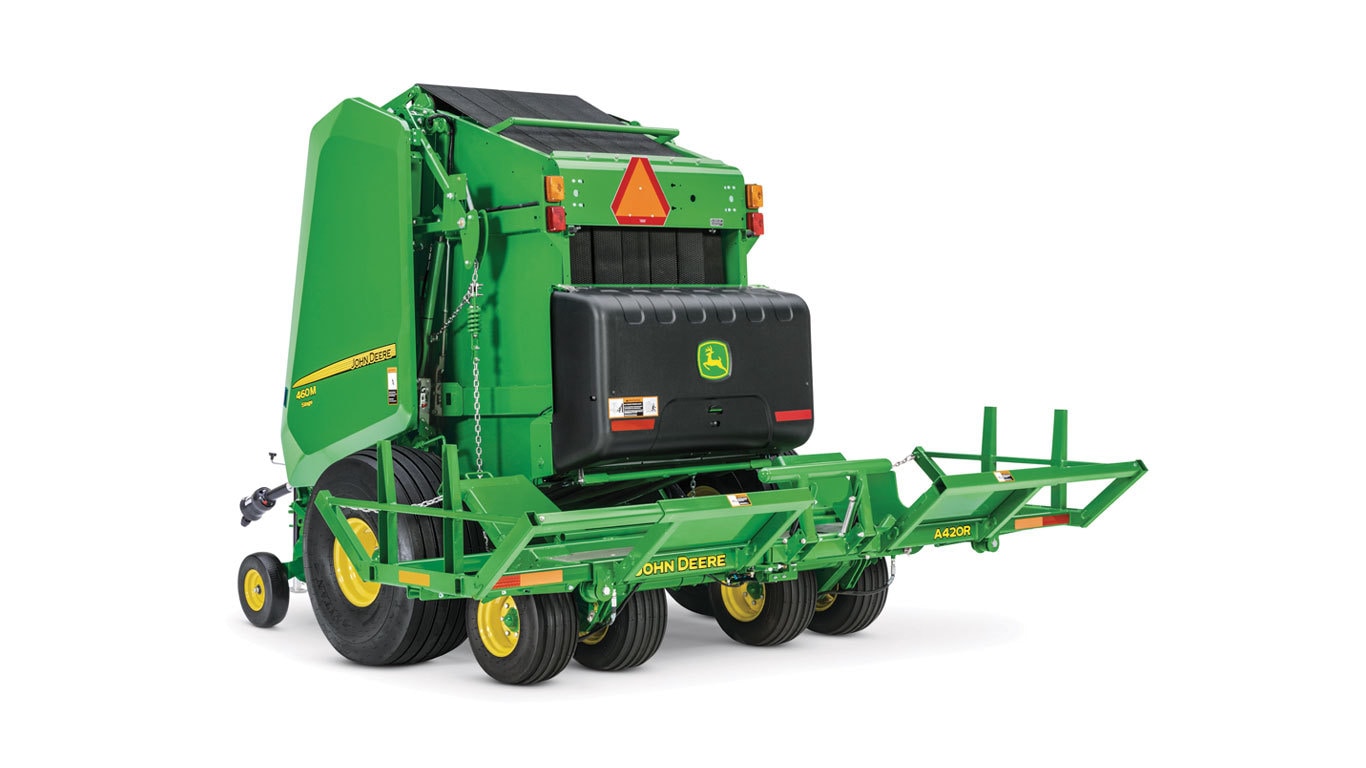 A420R Accumulator
A420R Accumulator -
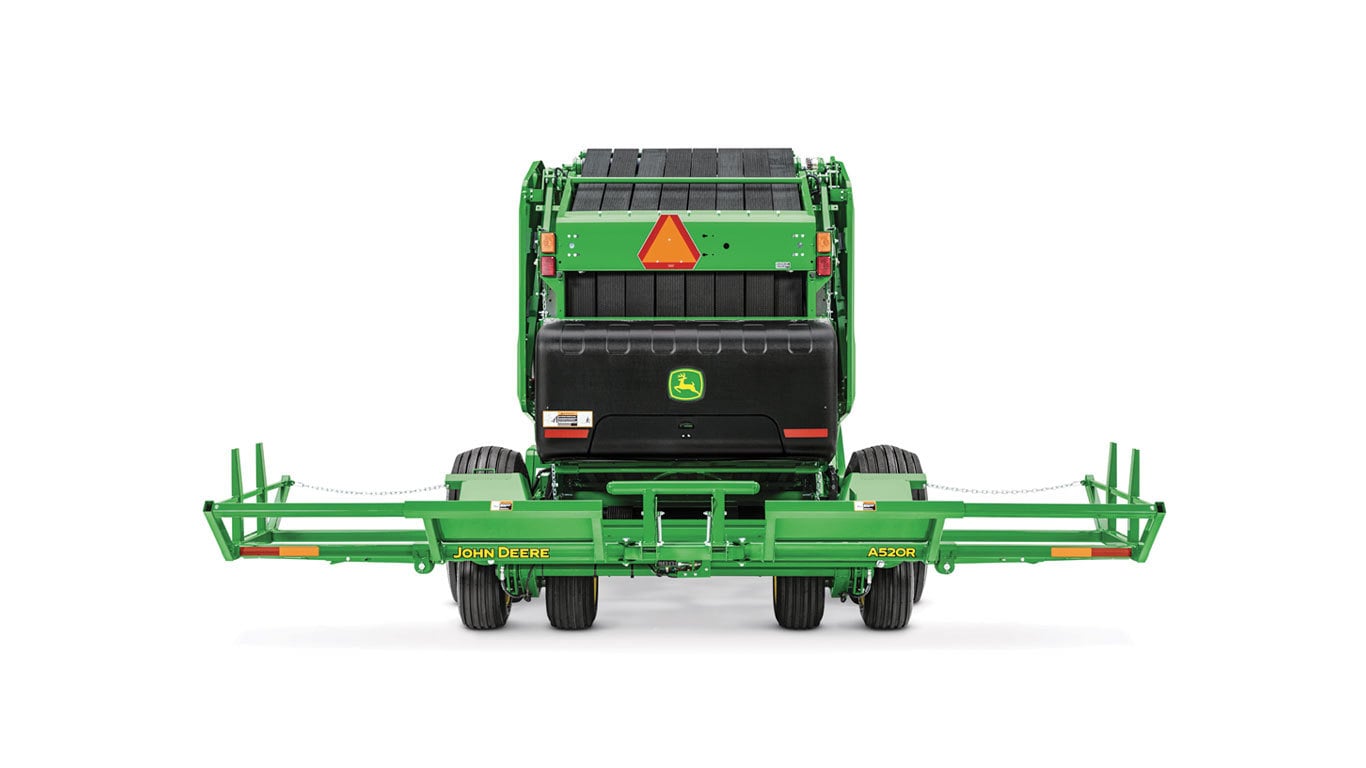 A520R Accumulator
A520R Accumulator -
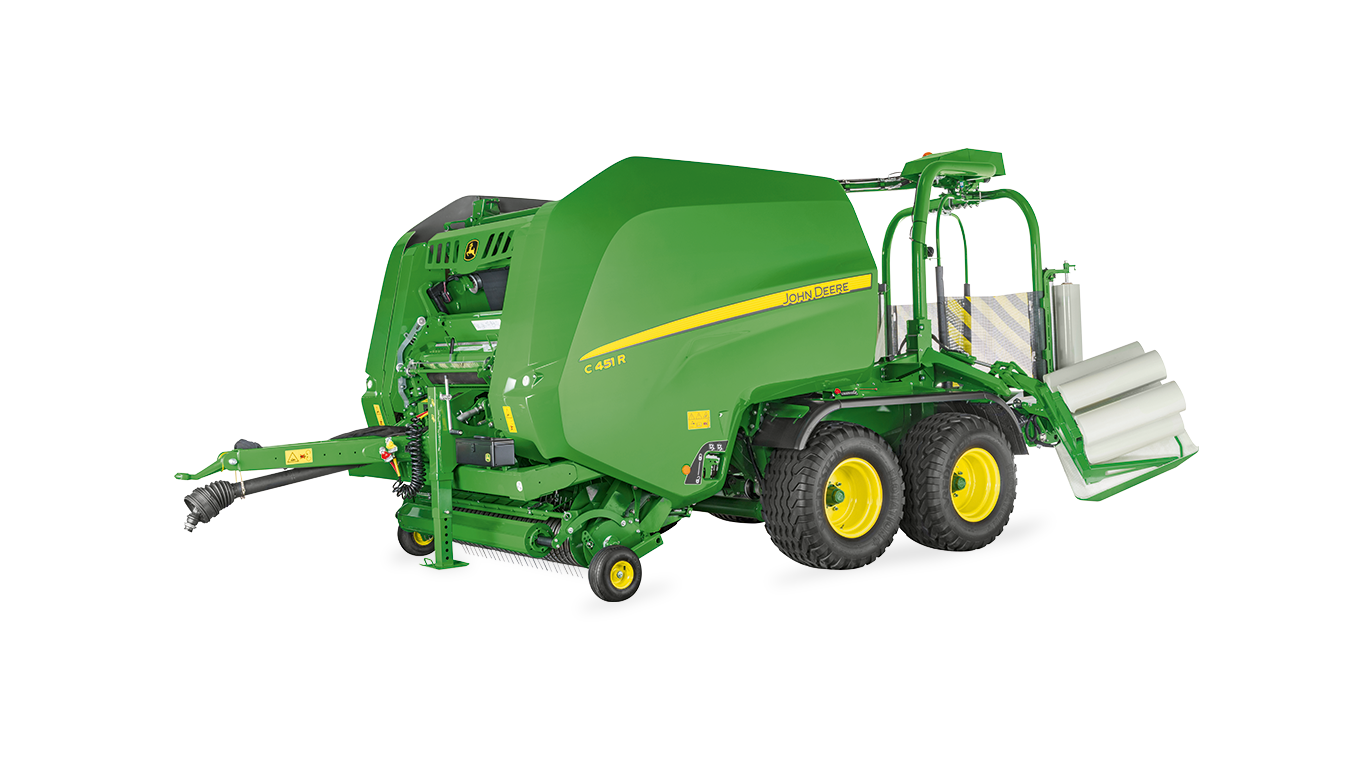 C451R Variable Chamber Wrapping Baler
C451R Variable Chamber Wrapping Baler -
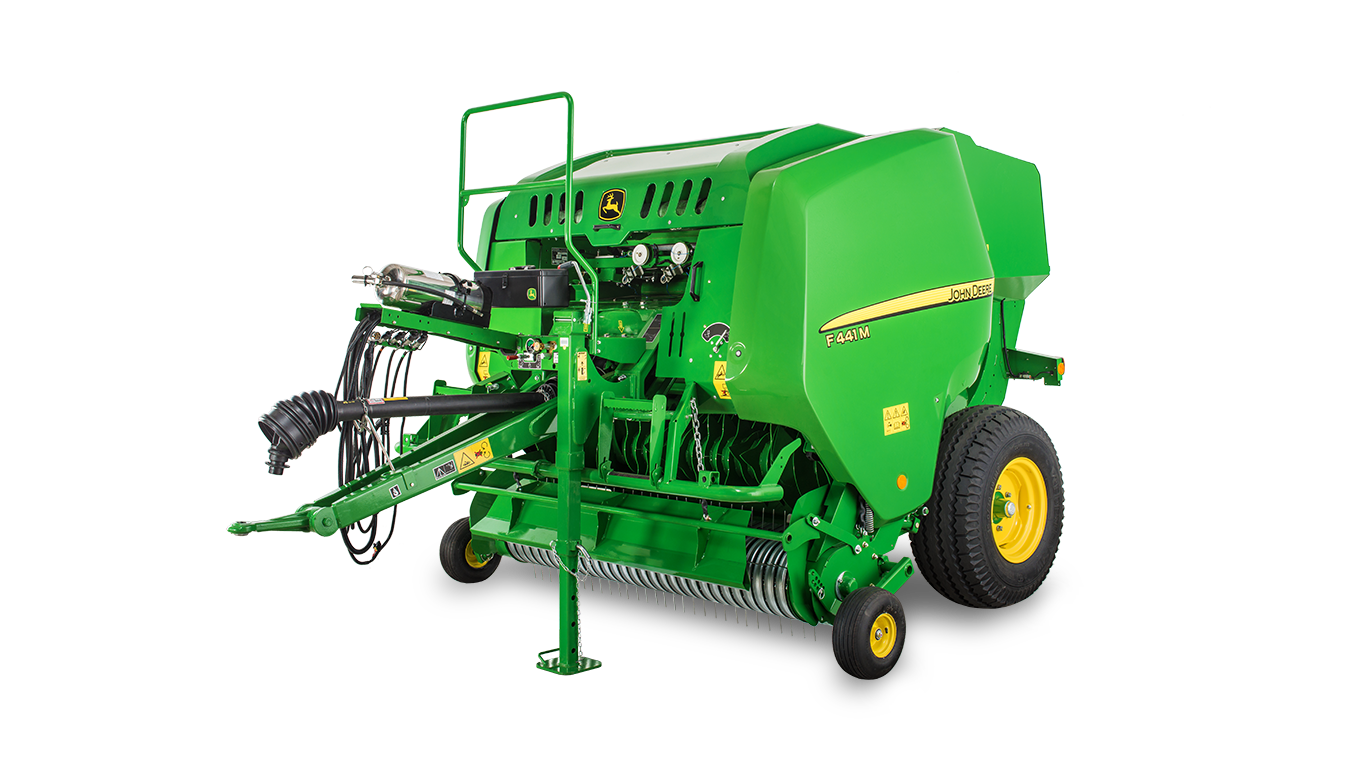 F441M Round Baler
F441M Round Baler -
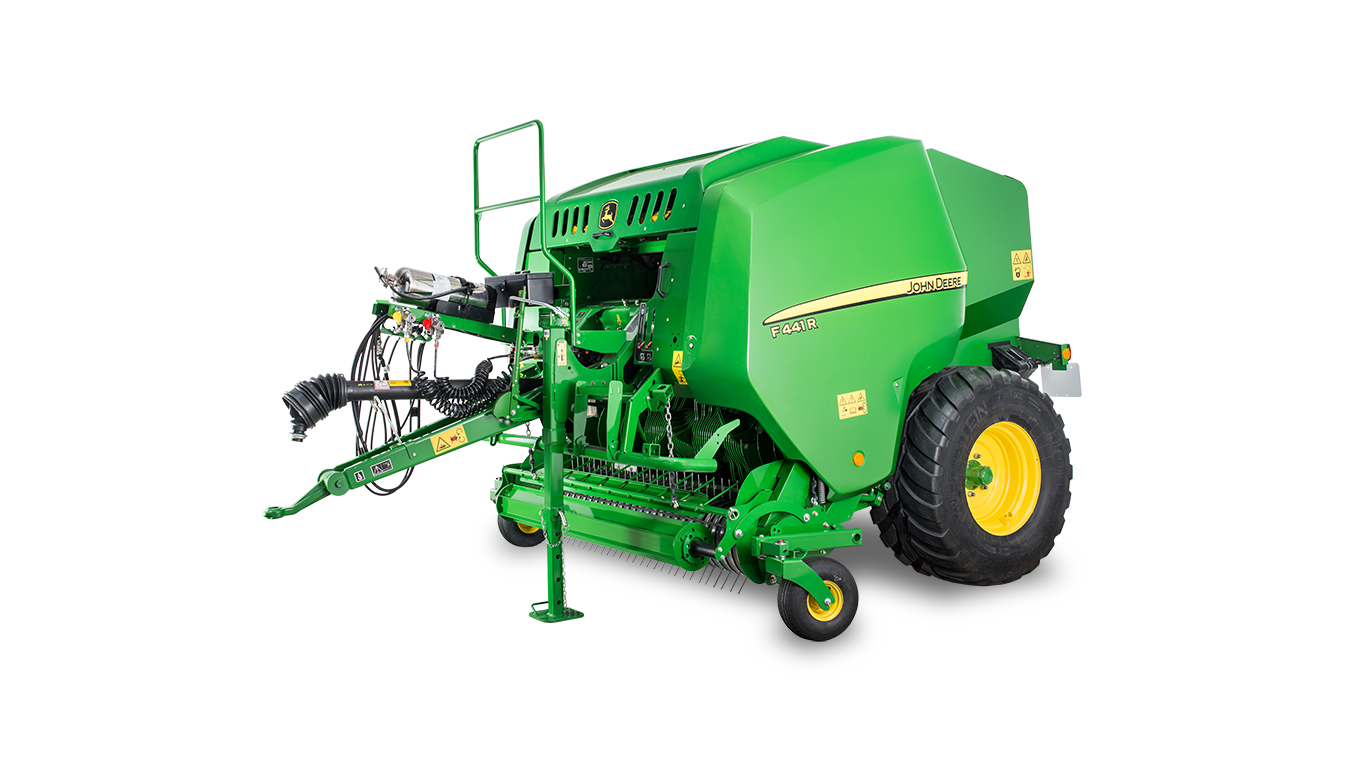 F441R Round Baler
F441R Round Baler -
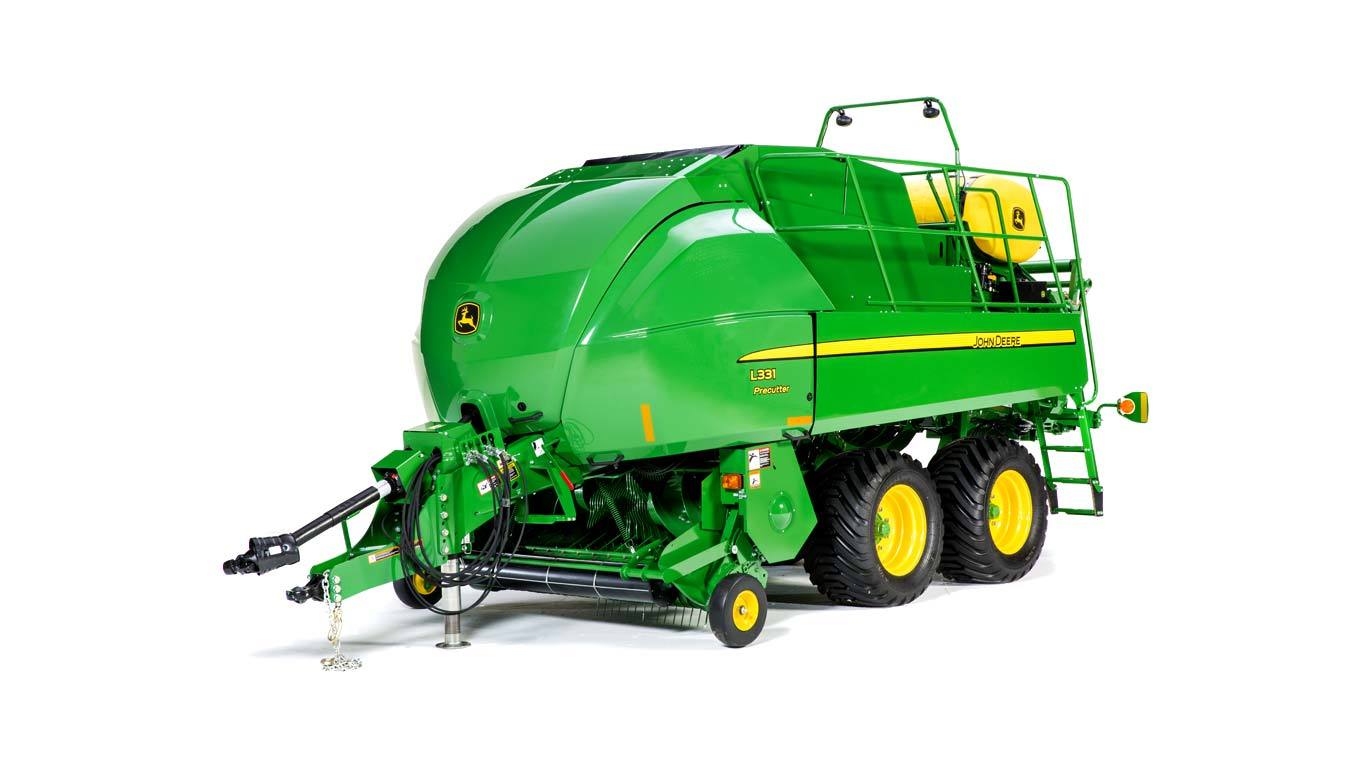 L331 Large Square Baler
L331 Large Square Baler -
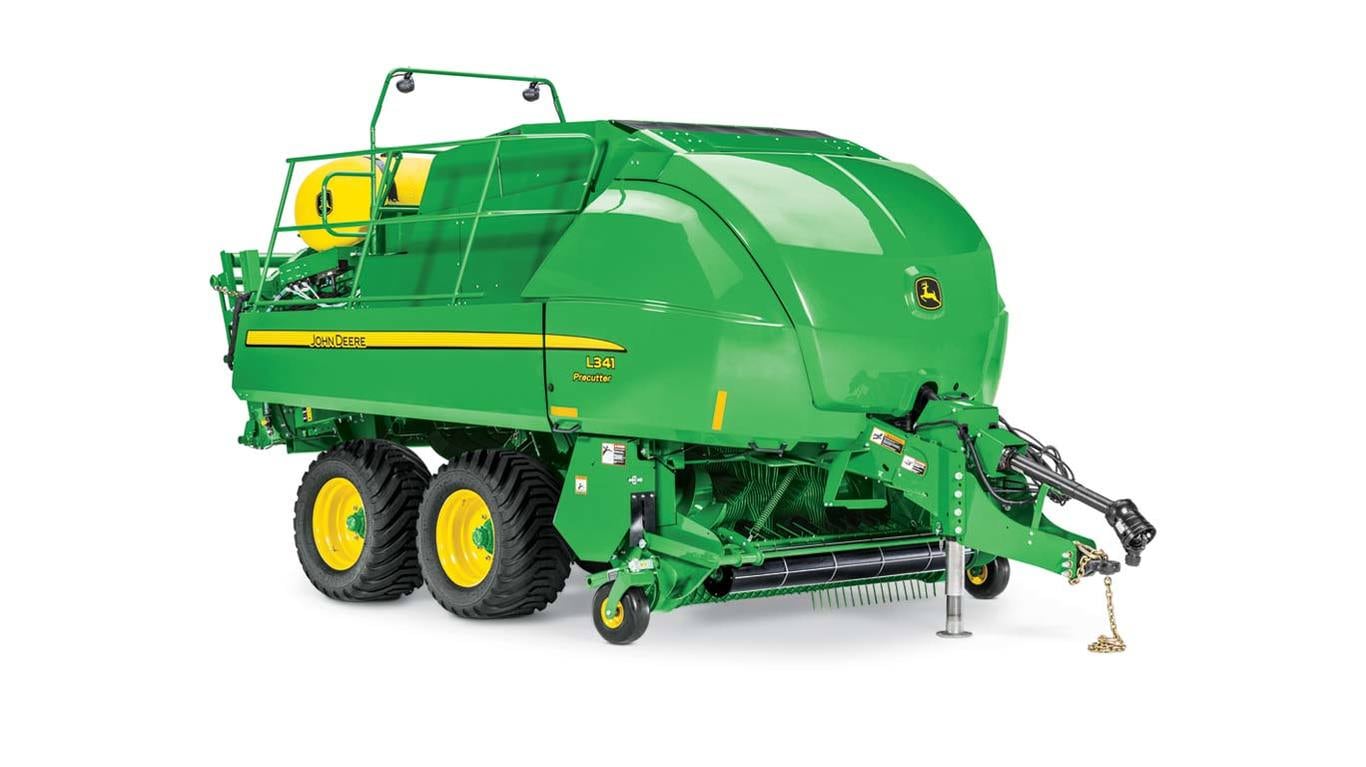 L341 Large Square Baler
L341 Large Square Baler -
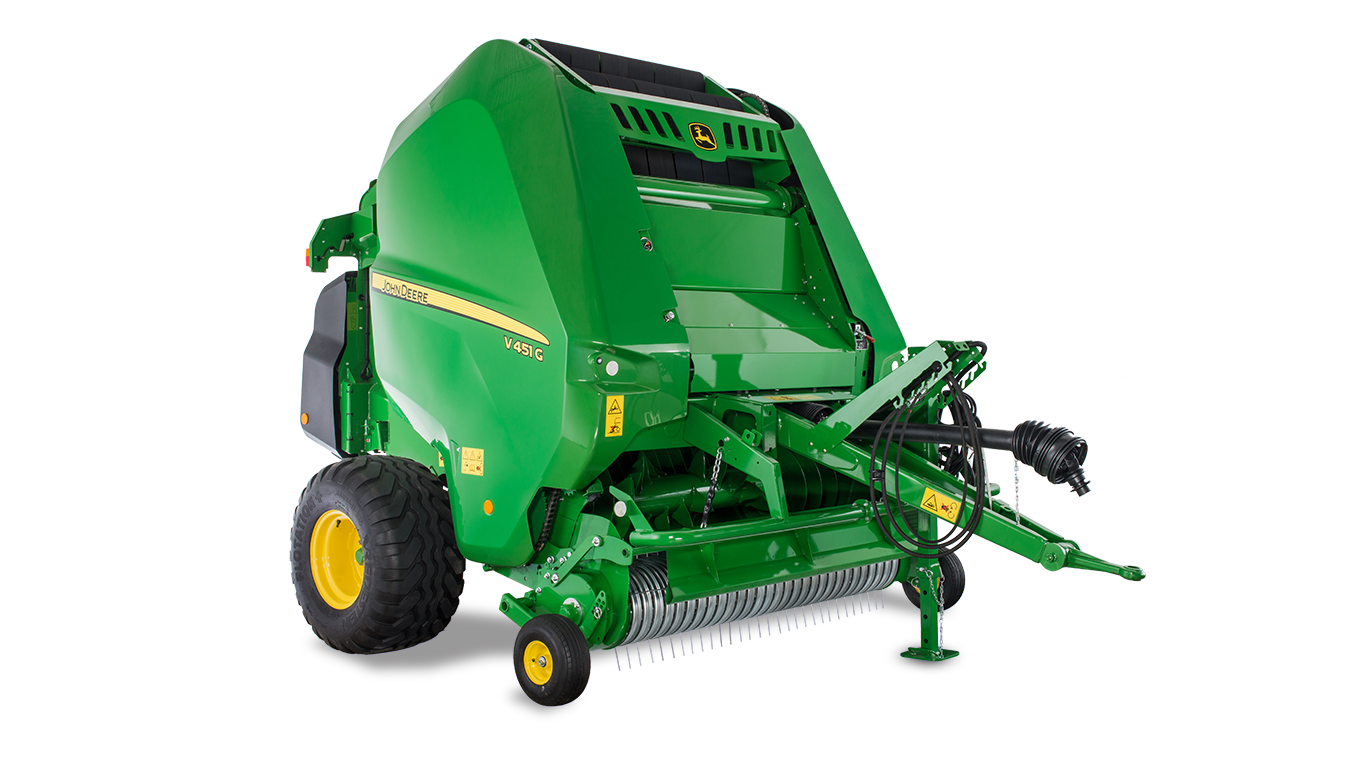 V451G Variable Chamber Baler
V451G Variable Chamber Baler -
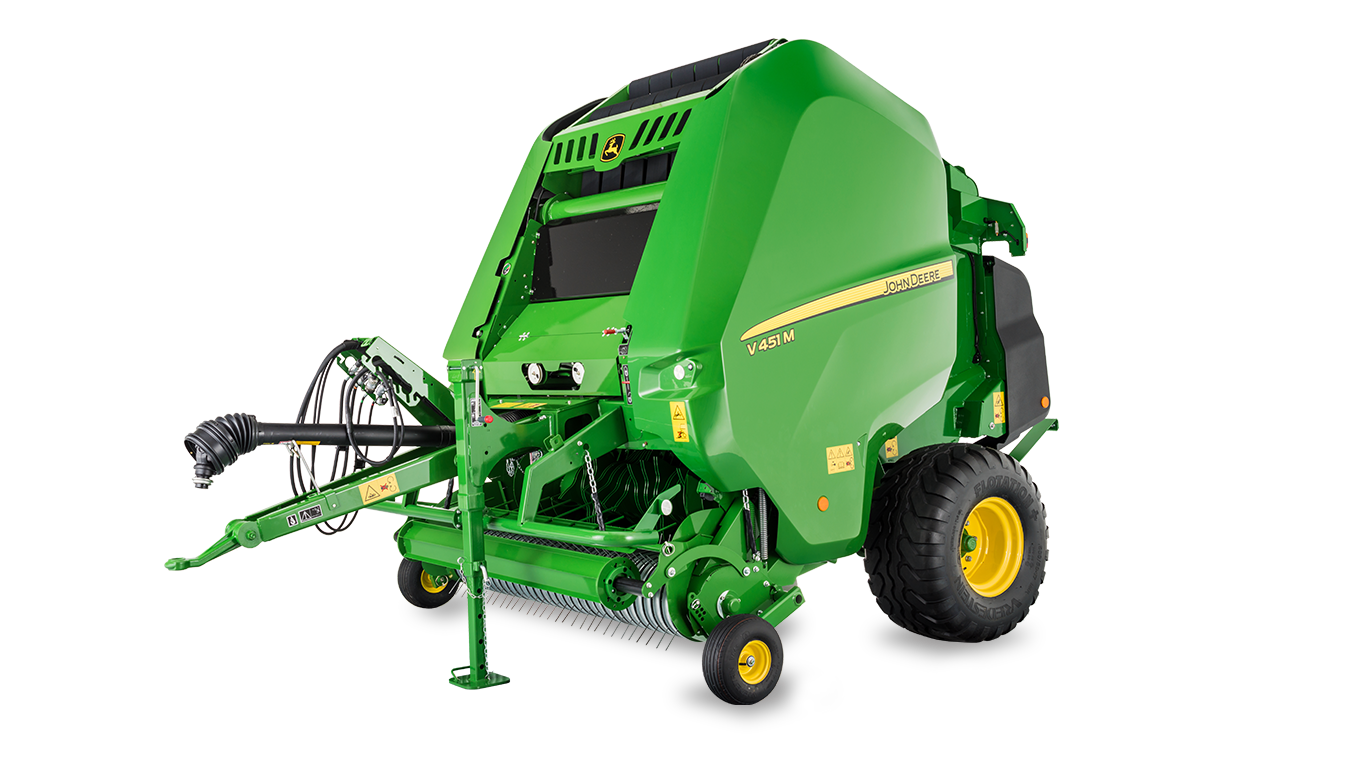 V451M Variable Chamber Baler
V451M Variable Chamber Baler -
 V451R Variable Chamber Baler
V451R Variable Chamber Baler -
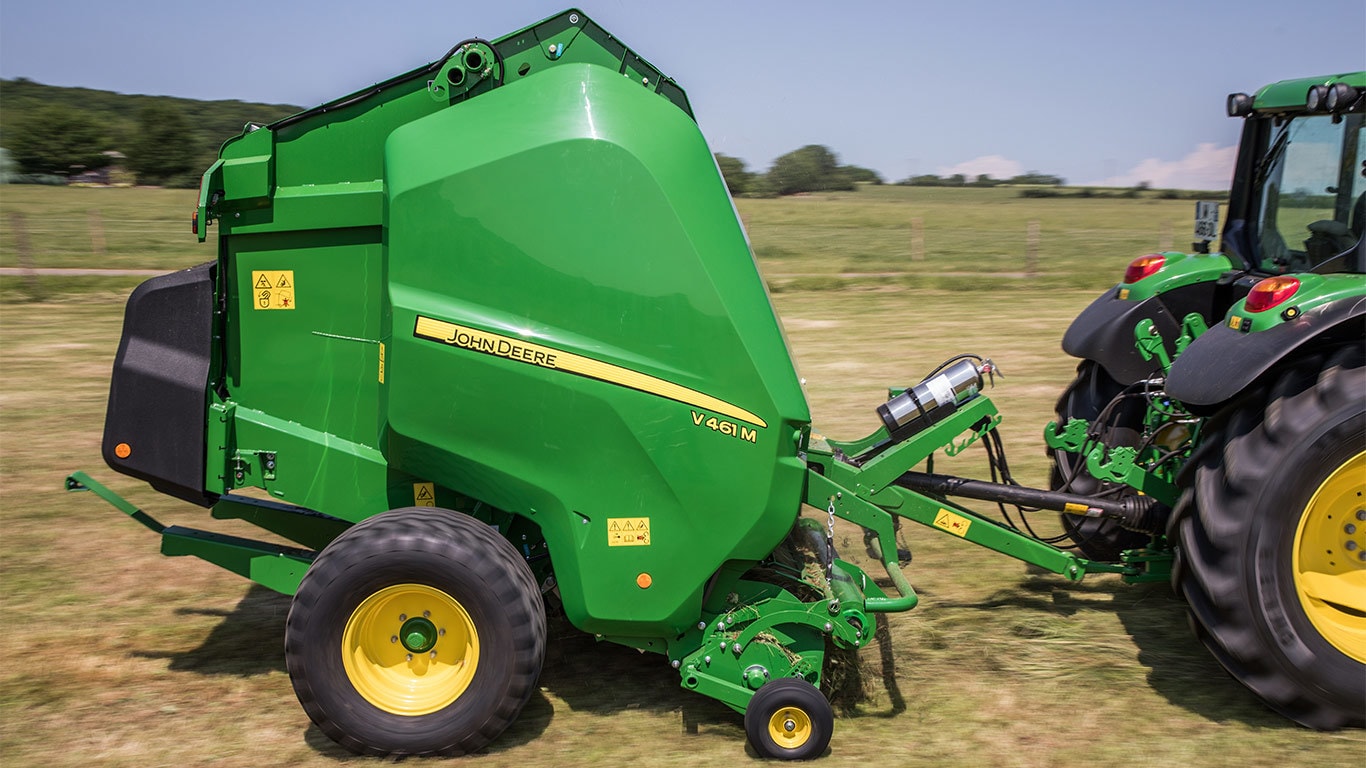 V461M Variable Chamber Baler
V461M Variable Chamber Baler -
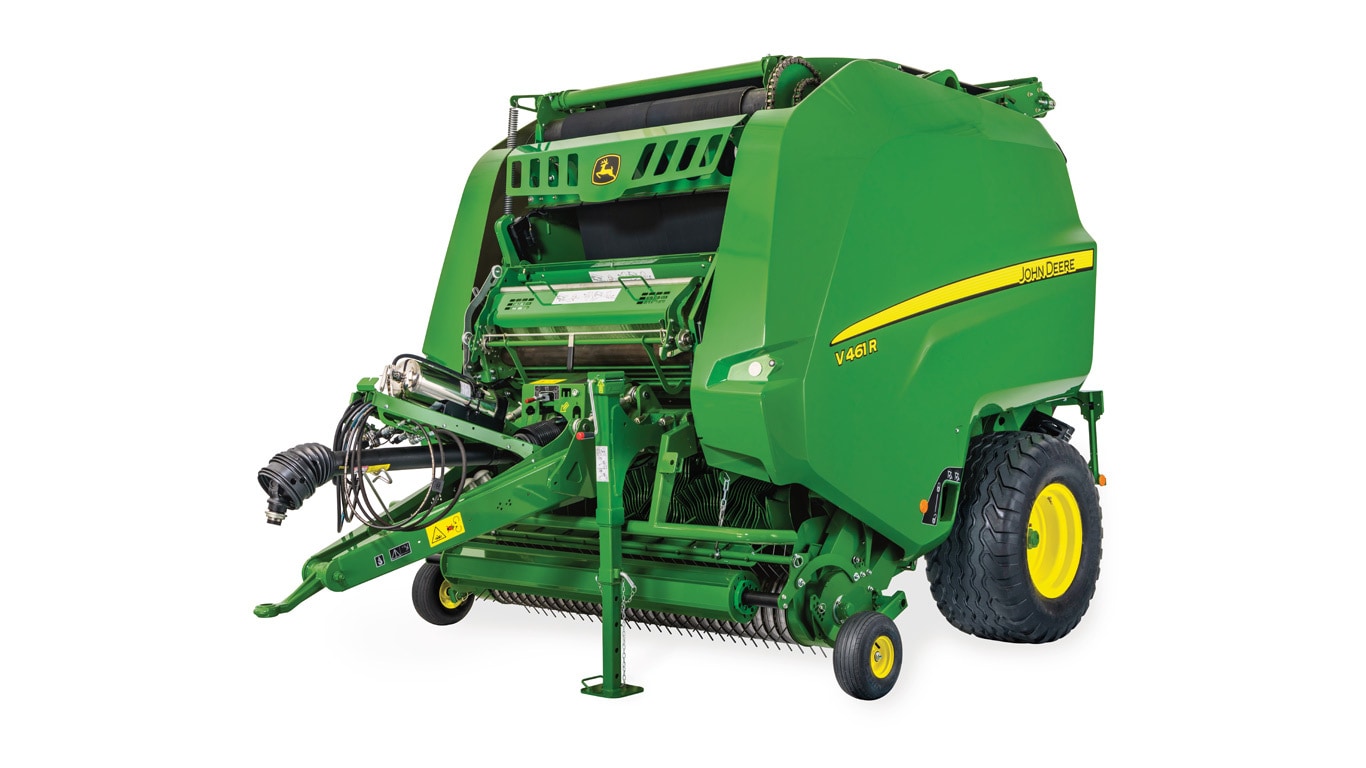 V461R Variable Chamber Baler
V461R Variable Chamber Baler
